It’s that time of year when winter squash overflows on grocery store shelves and the cooking possibilities are endless. Winter squash has a dense texture and mild, sweet flavor that hold up well in hearty soups, baked goods, casseroles and more.
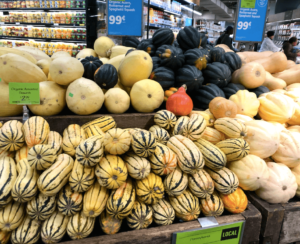
The air is crisp, the leaves are changing, and pumpkin spice everything is everywhere you go. It is officially fall, my favorite season! It’s time to enjoy the season’s harvest when flavors are at their best and nutrients are at their peak. Don’t be fooled by the ‘winter’ in winter squash, these hearty vegetables are best enjoyed now during autumn.
What is winter squash
The term winter squash is a bit of a misnomer. These plants are harvested in late summer or early fall. They are called winter squash because they have a thick hard rind that allows them to be stored and enjoyed throughout the cold winter months.
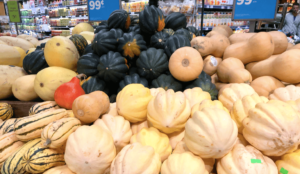
The most common winter squashes include spaghetti squash, acorn squash, and butternut squash. Other varieties include kabocha, delicata, hubbard, sugar pumpkin, and more. Each has a distinct texture and flavor. They can be used with a wide range of seasonings, and their mild flavor enhances and complements many of my favorite seasonal dishes such as: chili, risotto, autumn harvest salads, and pumpkin pancakes.
How to choose winter squash
The secret is to select a winter squash that feels too heavy for its size. This indicates the flesh inside is soft and moist, and ready to be enjoyed. A little surface scratching is normal but avoid any with bruises or deep cuts, which allow bacteria to enter. The skin of the squash should be dull and matte. If it’s too shiny it means it was picked too early. Also, the stem should be intact, firm and dry. If it is soft or moldy that means the squash is overripe and past its prime. Winter squash does not need to be refrigerated and can be kept in a cool part of your kitchen for several weeks.
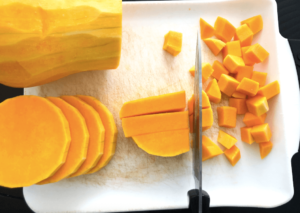
Nutrition
What makes winter squash so unique is the high level of beta-carotene, which the body converts to vitamin A. Vitamin A is essential for eye health, immune function, and regulating cell growth. Vitamin A and C are both antioxidants, which protect your cells from damage caused by free radicals (unstable molecules). Winter squash is also naturally low in calories and fat, but is packed with nutrients and minerals to include vitamin C, B6, folate, magnesium, and potassium.
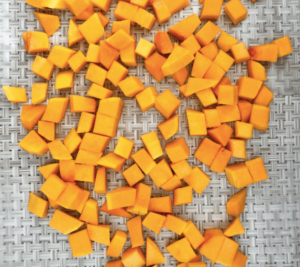
In addition, squash is a great source of both soluble and insoluble fiber, which most people do not get enough of in their diet. Soluble fiber helps slow the rate at which food is digested which contributes to satiety and helps regulate blood sugar levels. Soluble fiber can also help maintain healthy cholesterol. Insoluble fiber promotes bowel health and regularity. Depending upon the winter squash, it can provide anywhere from 2-10 grams of fiber per cup. Furthermore, this high amount of fiber helps reduce the risk of many diseases like heart disease, diabetes, and some cancers.
Cooking Methods:
Winter squash can be sautéed, steamed, baked, roasted, or microwaved.
Sautéed: Peel, deseed and cube squash into ½-1 inch cubes. Heat a large pan over medium-high heat and add olive oil or butter to lightly grease the bottom of the pan. Working in batches, add the squash in single layers, let cook for five minutes before stirring occasionally. Cook until squash is fork tender and lightly golden brown.
Steamed: Bring one inch of water to a boil in a large saucepan fitted with a steamer basket. Peel, deseed, and cube squash (1-2 inch cubes). Add squash to the basket, cover and steam until the squash is fork tender 12-15 minutes.
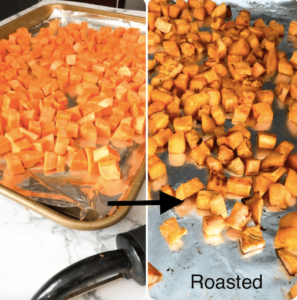
Baking: This method cooks squash in the oven at a lower temperature for a longer period of time. This ensures the squash is evenly cooked, soft on the inside and not burnt on the outside. Cut squash in half, deseed, lightly grease with oil or place butter in center. Can also add spices or seasonings like cinnamon, salt, or pepper. Place on baking sheet. Bake at 350-375° for 40 minutes-1 hour.
For example, cut an acorn squash in half and scoop out the seeds. Brush with maple syrup or melted butter and add cinnamon, then baked until tender. Spaghetti squash you have two cooking options. You can pierce the outside to let steam release and bake it whole. Once fork tender , let it cool and slice lengthwise to scoop the seeds and shred into ‘spaghetti’ like strands. Or cut the spaghetti squash in half, deseed, and place flesh side down on baking sheet until fork tender. Then scrape a spoon along the sides to ‘pull’ out the spaghetti strands.
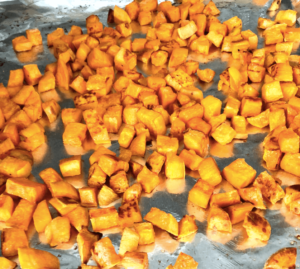
Roasted: roasting intensifies the flavor and gives a caramelized taste to the squash. First, cut squash into cubes (peel, deseed and cube) or slice into wedges (like acorn squash). Then toss or brush with oil and your favorite seasonings (or can use maple syrup), roast at 400-425° for 25-40 minutes.
Microwaved: this method is great if you have difficulty cutting a raw squash. Using a sharp knife, make several slits in the skin to allow steam to escape, and prevent it from exploding. Place the squash in a microwave safe dish and place in the microwave on high for 8-10 minutes. Continue to cook at 1- minute intervals until a fork or knife can easily sink into flesh. Remove the squash and allow to cool enough to handle. Finally, cut the squash in half lengthwise and remove seeds , and scoop out the flesh. Cook times will vary based on the size and variety of the squash.
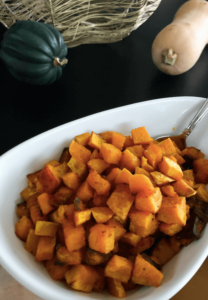
Versatility:
Although it’s a delicious side dish eaten on its own, its mild sweet and nutty flavor makes it a great addition to many dishes. Add cubed, squash to soups, chilis, grain dishes, tacos or burritos, salads and much more. Additionally, blend cooked squash into soups, pasta sauces, muffins, pancake batters, breads, pies and more. Also, you can stuff half a baked squash with a mixture of rice, lentils, vegetables and/or ground meat.
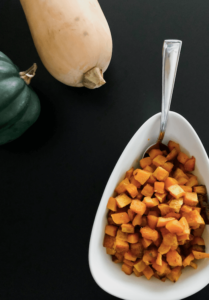
Finally, check out my recipe below for Roasted butternut squash. Roasting butternut squash, turns the tough gourd into a soft, sweet and caramelized ingredient. The outside gets slightly browned, with crispy edges and a creamy interior. This roasted butternut squash is delicious enough to eat on its own as a side or adds vibrant color and delicious standout flavor to any dish. Substitute the roasted sweet potato in my Vegetarian Enchilada recipe for the roasted butternut squash this time of year. Also, feel free to substitute with a different winter squash like delicata, acorn or kabocha.
Roasted Butternut Squash
own as a side, or can be incorporated into seasonal meals5-7 servings (less if it is used as side, more if it is incorporated in a dish)
Ingredients
- 1- large butternut squash peeled & deseeded
- 2 Tablespoons olive oil
- 2 teaspoons seasoning Season to your liking any combination sweet or savory: black pepper, garlic pepper, cinnamon, nutmeg, cayenne pepper, etc
Instructions
- Preheat oven to 400° Fahrenheit. Line a baking pan with aluminum foil and lightly grease (or you can use parchment paper).
- Cut butternut squash into ½- 1 inch cubes and place in a large mixing bowl.
- Drizzle olive oil, season with seasonings of choice (can do sweet or savory), stir well. Spread butternut squash in a single layer on the baking pan.
- Bake for 30 minutes, stirring every 10 minutes, until butternut squash are soft and lightly browned. Remove from oven and let cool.
Nutrition Facts
What is your favorite way to prepare winter squash? Share in the comments below.
Roasted Butternut Squash

NEVER MISS A RECIPE! Sign up for free recipes delivered straight to your inbox! Sign up below